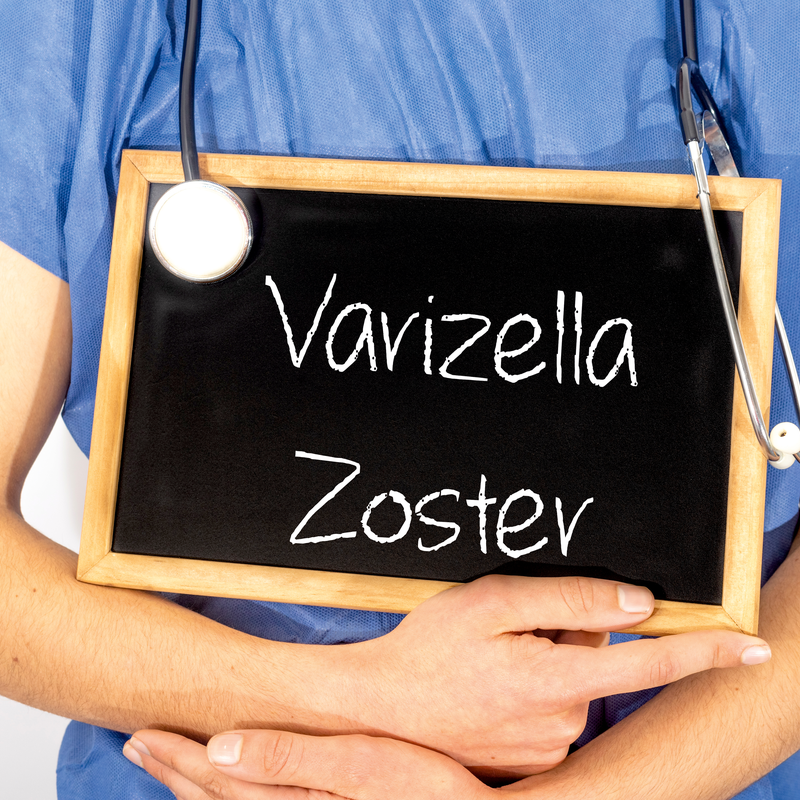
What is the varicella-zoster virus?
The Varicella-Zoster-Virus, VZV for short, is a virus from the group of eight herpes viruses. In addition to the childhood disease chickenpox, the virus also causes the well-known shingles.
What is the morphology of the varicella zoster virus?
The VZV is a virus that is enveloped in a membrane. This consists of an icosahedral nucleocapsid. The capsid contains a double-stranded DNA. The varicella-zoster virus has a size of 180 to 200 nm. The capsid has a diameter of about 100 nm.
How is the varicella-zoster virus transmitted?
The virus spreads mainly by droplet infection via the highly contagious skin blisters and leads to chickenpox at the first infection. After about two to three days, the viruses multiply in the lymph nodes and the first viraemia occurs. After about 10 to 14 days, the virus multiplies in the spleen and liver and the second viraemia occurs. This then manifests itself through the appearance of the skin blisters. Although you are then immune to chickenpox for life, the virus remains in the nerve fibres and can break out again at any time as shingles.
How contagious is the varicella-zoster virus?
The infectiousness of the VZV is illustrated by the example of shingles. You can only get shingles if you have already had chickenpox from the varicella-zoster virus. This is the same pathogen. The infectivity of chickenpox is very high. For every 100 people infected, at least 90 others will get the disease if they have had contact with the infected person.
What are the symptoms of varicella-zoster virus?
The varicella-zoster virus is mainly the cause of two diseases: Chickenpox and shingles. That is why there are also different symptoms of each disease.
Chickenpox
Initially small red spots form on the trunk and face in the early stages of chickenpox. Within a few hours, these develop into small blisters that are filled with a clear fluid . At the same time, the body temperature of those affected rises to 39 degrees. In many cases, however, no fever develops at all. The rash spreads to the arms, legs, the mucous membranes of the mouth, genitals and scalp. This means that the entire body is covered in a very short time. New blisters form constantly for about three to five days . After about one to two days, these dry up and crust over. The number of skin blisters varies completely from patient to patient . As a rule, the number is approximately between 200 and 250. Smaller children usually show fewer skin blisters than adults.
Shingles
The symptoms of shingles vary from case to case and cannot be generalised . It also always depends on the severity of the outbreak. Most of the time, the symptoms follow a certain pattern.
During the early phase of the disease, no specific symptoms or complaints occur. Patients mainly complain of fatigue, general signs of illness, headache, aching limbs and mild fever. The affected areas of the skin may experience discomfort such as tingling, which turns into pain after three days and the typical shingles skin rash develops. The pain is felt to be very strong. This is because the varicella zoster virus attacks the nerves. This pain is usually present before, during or even after the rash . Even after the disease itself has healed, post-herpetic neuralgia may remain.
How is varicella zoster virus diagnosed?
People with suspected chickenpox or shingles usually visit the family doctor. The doctor can obtain important information from the medical history and a physical examination. However, since the symptoms can also stand for other diseases, it is important that the varicella-zoster virus can be proven without a doubt . This can be done in two ways:
- Direct detection: Varicella zoster viruses can be detected directly in the laboratory with the help of a wound swab. For this purpose, a PCR test is carried out or a special cell culture is grown.
- Indirect detection: The blood of the person affected is searched for corresponding antibodies against the varicella-zoster virus. If the brain is affected, an examination of the cerebrospinal fluid is indispensable.
How is the varicella-zoster virus treated?
The childhood disease chickenpox and the subsequent disease shingles are treated symptomatically for the most part. For the pain, medicines like ibuprofen or paracetamol can be taken. With their help, the body temperature can also be lowered if the fever is very high. If the pain is more severe, a doctor may prescribe stronger painkillers. The rash and the skin blisters can be treated with ointments or tinctures depending on the stage, so that the itching becomes more bearable. In addition, the affected person is given an antiviral medication to fight the virus .
What is the prognosis for varicella zoster virus?
In about two thirds of those infected, chickenpox or shingles heal without complications. Normally, a person only gets chickenpox once. However, because the pathogen remains in the nerves and can break out again and again, there is a risk that shingles will reactivate several times. Even an antiviral treatment can only inhibit the reproduction of the virus . But it cannot kill it.
How can the varicella-zoster virus be prevented?
For people who have never been infected with the VZV in their lives, there is no better protection than vaccination. It protects against chickenpox and, of course, against the subsequent shingles. In the meantime, you can even get vaccinated against shingles itself. This greatly reduces the risk of getting shingles. The vaccine consists of a dead vaccine, unlike the used so far. This means that the vaccine does not contain living pathogens, but killed ones. This makes the vaccination much more tolerable.
